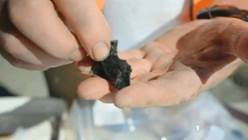THE EVER GROWING LIST OF NEWLY DISCOVERED SITES THAT HAVE TO BE DATED TO 1300 AD BY OUR SO-CALLED EXPERTS.
The days of open research and follow-on, healthy debate seems to have died with Lesley Adkin, Russell Price and a raft of other old-school seekers after truth, then replaced by compliant social-engineers intent on not stepping-out-of-line and thereby committing career-suicide.
Every second day it seems, some new archaeological site comes into public attention and is touted in the media as being the latest or newest “oldest” site to be found in New Zealand or, at least, represented as being nearly contemporary to Wairau Bar in age. Moreover, these sites or settlements are often very large and were once host to a sizable, long-term populations. Let’s enumerate a few mentioned in recent media releases:
Motorua Island headlines:
"Dig uncovers New Zealand's earliest arrivals"
The dig site, at Mangahawea Bay on Moturua Island, could be one of New Zealand's earliest settlements
https://www.nzherald.co.nz/northern-advocate/news/article.cfm?c_id=1503450&objectid=11785091
"We Know the site is early. The question is, how early?"
New finds while the Advocate was visiting on Wednesday included a possible moa-bone spear tip, a kuri (dog) tooth and a piece of red ochre pressed into a crayon-like shape. Ochre was used to decorate everything from bones to paddles by early Maori.
If the fishing lures were found to be pearl shell and dating confirmed the site was as early as suspected, that could mean it was used by the first generation of Maori
and was as old as Marlborough's Wairau Bar, the most famous of the early sites found so far."
https://www.doc.govt.nz/parks-and-recreation/places-to-go/northland/places/moturua-island-scenic-reserve/moturua-island-scenic-reserve/
I found the video clip associated with this dig particularly telling. The archaeologist spokespeople were so dramatic, practiced and emphatic, with plenty of hand gesticulations to nail down points before the cameras. I’m sure the Maori individuals who stood behind gave their “thumbs up” to the very polished, gushy performances, but were probably laughing under their breath at the same time, knowing full-well that the sites preceded Maori occupation. Their learned elders would, undoubtedly, have known the real, unbastardised history of the region and the Turehu groups they encountered and displaced upon arrival in the district.
GISBORNE PORT
https://www.stuff.co.nz/dominion-post/news/hawkes-bay/104347485/ancient-mori-village-discovered-under-gisborne-port--reports
Again, a large settlement dated to 1300 AD or contemporary with Wairau Bar.
WHITIANGA
- Taputapuatea Stream -
http://www.stuff.co.nz/waikato-times/news/10360939/14th-century-Polynesian-settlement-discovered
Again, this recently found large settlement is supposed to date back to the early 1300s and would be contemporary with Wairau Bar.
The problematic aspect posed by all these sites is that cooked Moa bones and artefacts fashioned from them keep turning up and this puts the social-engineer archaeologists or their handlers in a bind. The irrevocable stipulation is that the sites MUST be of Polynesian Maori, while admitting that there can be no living Moa beyond about 1350 AD. Therefore the archaeologists are locked in to dating the sites to around 1300 AD as they're not allowed to date them any (or much) earlier and still be within the set-in-concrete Maori epoch.
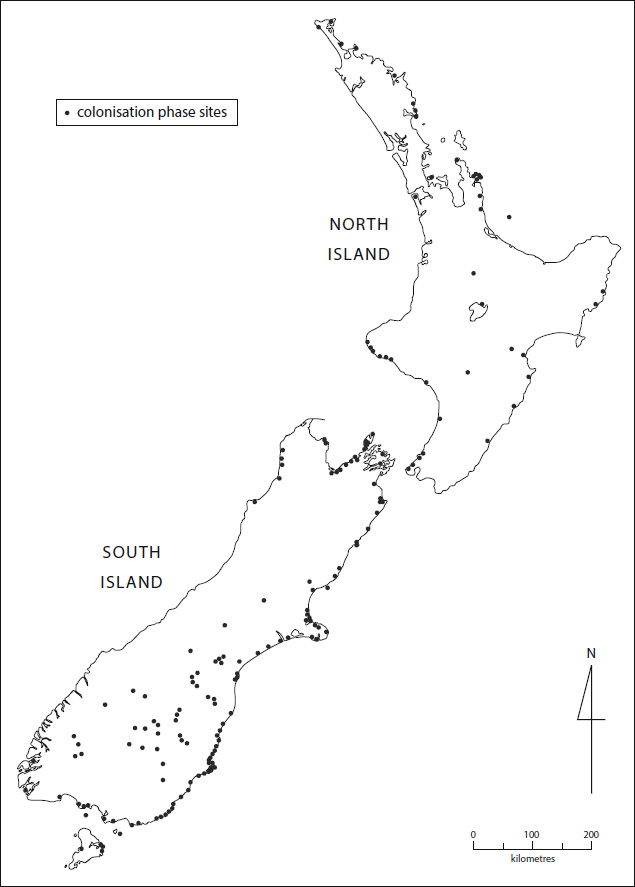
This picture gives us a glimpse of just how ridiculous and impossible the mainstream population model truly is. Each dot represents a site of human occupation (many with very large populations) where cooked Moa bones or artefacts made from the giant bird bones were found. Each of these "Colonisation Phase Sites" is said to have been inhabited in the 14th century AD (1300s).
Let’s look at another site, the former estimated age of which has been severley juggled to force it into the "approved" time-frame of Maori occupation.:
KORU PA
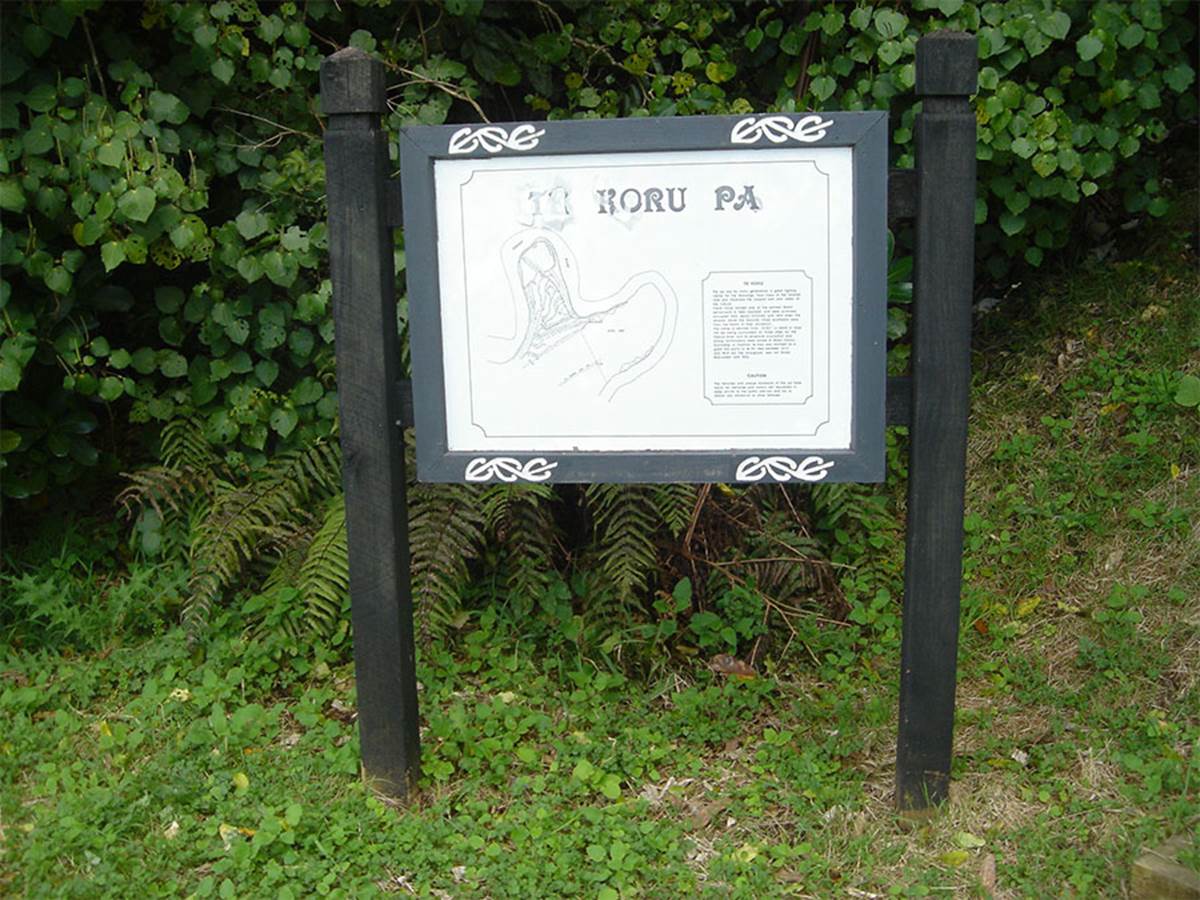
Here’s the old sign which stood at the entrance to Koru Pa in 2003, before the implementation of enforced “right-thinking” about the age of Maori sites.

This is what the sign said in 2003. Note: Nigel Prickett and other researchers had concluded that the site was probably occupied from about 1000 AD.
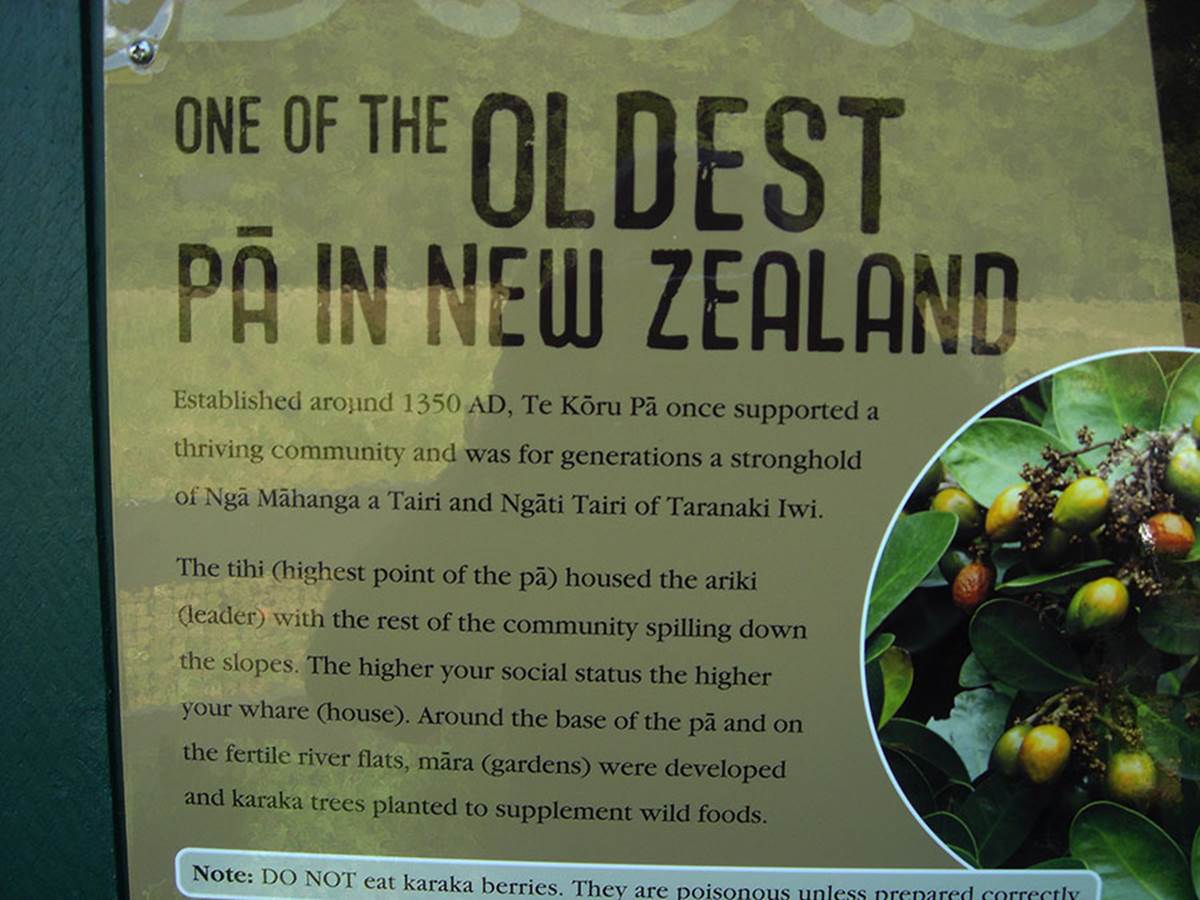
Within a short time beyond 2003, the old sign was replaced by a new one, part of which is shown in this picture. Quite suddenly, 350-years had been lopped off the age of the PA, to bring its date into the range of right-thinking. We, the public, were not informed concerning the startling new finds that must’ve been made in order to readjust the date so radically.
How can we have any confidence in these turkeys when they pull stunts like this without explanation? Do they have even the most minimal idea of what they’re talking about as they make adjustments to our historical record, based solely upon politically-correct or racially-sensitive criteria or requirements? What we the public require is “warts-‘n–all” truth!
Maori oral traditions related to Koru PA speak of the region being occupied by an altogether different, non-warlike people when Maori first arrived in the district.
This re-dating is a radical-departure, without explanation, from the earlier accepted date and can only be politically motivated. It was undoubtedly due to critical commentary appearing in the Internet which pointed out the massive contradiction between circa 2003 academic-dating and wording on the original sign.
So, what spawned this rethink and hard-nosed reentrenchment, to lock-down immovable dates of the Maori epoch, coupled with absolute, vehement denial that anyone else inhabited New Zealand before the Polynesian Maori found these shores?
In 2003, in the wake of much public counter-argumentation that there were most-certainly people living in New Zealand before the coming of the Polynesian Maori, our leading-lights kindly returned to assessing their accumulated data and decided they were right all along … there was no evidence of any human impacts on the New Zealand landscape until the year 1300 AD.
To read an overview of the whole sorry affair and the infighting that it spawned at an academic level, read: The Prehistory Dating Game, by Simon Collins, New Zealand Herald, 24th January 2003.
https://www.nzherald.co.nz/nz/news/article.cfm?c_id=1&objectid=3097798
But let’s consider what other structures sit within a short distance of huge, stone-walled Koru PA (the stone PA) which, in and of itself, entailed huge excavations and withering-labour to build the multi-tiers, high walls and network of tunnels, with a river moat almost circumnavigating the whole massive hillock structure.
Further down the river towards the coast are yet more PA, riddled with the self-same souterrain tunnels. There’s another large one on a hill there at Kaitake and a huge one nearer to Oakura township that would approach the size of Turuturumokai in Hawera, Taranaki. Turuturumokai has perimeters so large that it would not have been possible to defend the fortification without thousands of troops.
So, we’re talking about 1300 AD, right? This is the dawn of the Maori epoch, right? There aren’t many Maori in the country, right? So why did they need so many, within-a-stone’s-throw, concentrations of large PA to defend themselves (all over New Zealand).
The Prehistory Dating Game article mentions:
‘In a remarkable piece of genetic detective work, Penny and others have calculated the founding population of Aotearoa must have been at least 100 to 200, including at least 50 females, in order to grow to around 100,000 with the amount of genetic diversity existing when Europeans first arrived.’
OK, so here’s a list of a few hundred PA and other sites solely for the vicinity of New Plymouth, Taranaki alone, with many sites dated at circa 1300 AD.
http://www.newplymouthnz.com/-/media/NPDC/Documents/Council%20Documents/Plans%20and%20Strategies/District%20Plan/District%20Plan%20Appendix%2026%20Waahi%20Tapu%20sites%20and%20archaeological%20sutes.ashx?la=en
How does this academic arithmetic work? One also has to take into account the depletion of Maori numbers through constant warfare, utu killings, muru (plunder killings), the castration of captive slaves, rampant cannibalism, disease-driven mortality and infanticide.
This population model, laid-out alongside so many huge and laboriously built structures, cannot account for even a small percentage of the massive terrain modifications undertaken across the length and breadth of New Zealand. Such a stupid scenario is not only ludicrous and unworkable in the extreme, it’s an absolute impossibility!
AUCKLAND ISTHMUS.
Here, in part, is Dr Janet Davidson’s report about Motutapu Island showing the archaeological finds just on that one island alone.
http://www.jps.auckland.ac.nz/document//Volume_87_1978/Volume_87%2C_No._4/The_prehistory_of_Motutapu_Island%2C_New_Zealand%3A_Five_centuries_of_Polynesian_occupation_in_a_changing_landscape%2C_by_Janet_Davidson%2C_p_327-338/p1
It states:
"One deposit — the occupation under the Rangitoto ash at the Sunde site — is clearly earlier than any other. There are grounds for thinking it immediately preceded the eruption, and can be dated to the early or mid-fourteenth century." (Of course 14th century means the 1300s.)
(Volume 87 1978) Volume 87, No. 4, The prehistory of Motutapu Island, New Zealand: Five centuries of Polynesian occupation in a changing landscape, by Janet Davidson, p 327-338 )
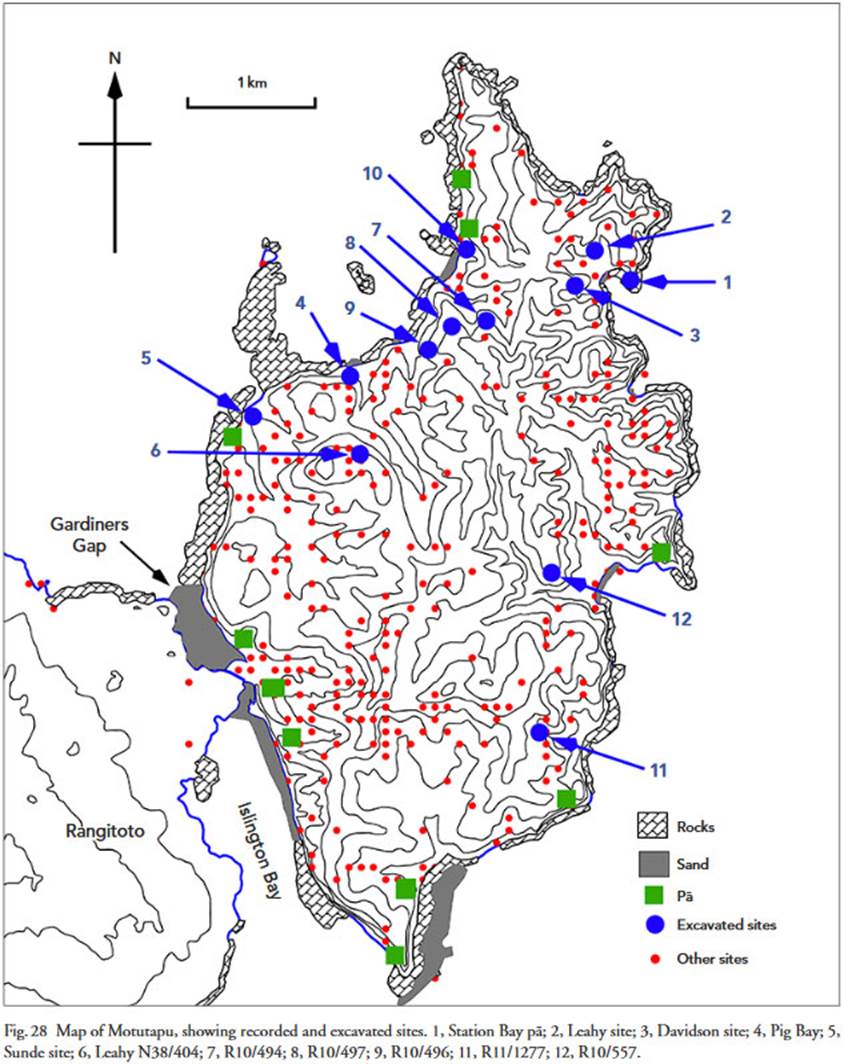
The archaeological sites of Motutapu Island, including 10 PA fortresses.
So, why are our archaeologists so hell-bent on a 1300 -1350 AD date for the Motutapu settlement? In light of the scant time-frame to do all this human endeavour, why is it so repugnant to accept that the occupants of the island were pre-Maori people?
1. For many years we were taught that Rangitoto Island volcano, sitting adjacent to Motutapu, erupted violently from the sea only about 600 years previously but in 2013 (probably due to challenging critical analysis appearing on the Internet) it was finally, officially admitted that the island has been around for about 6000-years. Many New Zealanders are led to believe that the name Rangi-toto means "fire in the sky" or "blood sky" and from this conclude that Maori witnessed the violent eruptions of this volcano when it was fully active. As it turns out, the name has nothing to do with "fire in the sky", but is an abbreviation of the sentence: "Te Rangi i totongia a Tamatekapua - the day the blood of Tamatekapua was shed". The oral history is referring to Tamatekapua, chief of the Arawa canoe, which arrived about 1350. He was defeated in a battle against the Tainui at Islington Bay on the Island.
2. Rangitoto Island volcano did nothing more than dump about 1-metre thick of ash deposit on adjacent-joined Motutapu Island in the early to mid-1300s.
3. But hold-on, there was already a large, long-term settlement on Motutapu by the early to mid- 1300s and their village sites, gardens and graveyards (urupa) were now locked in an ash-covered time warp.
4. For this archaeological time-capsule to be deemed Maori, despite the all-too-scant time-frame offered between arrival then building up such a large settlement, it meant that there would need to be some very creative manipulation of the findings and fudging of the results.
5. In some of Davidson’s photos one can just make out that the skeletons exhumed have the flat, non-Polynesian Jaw and the more bulbous head form. They were also found in the trussed, foetal position burials consistent with pre-Maori custom.
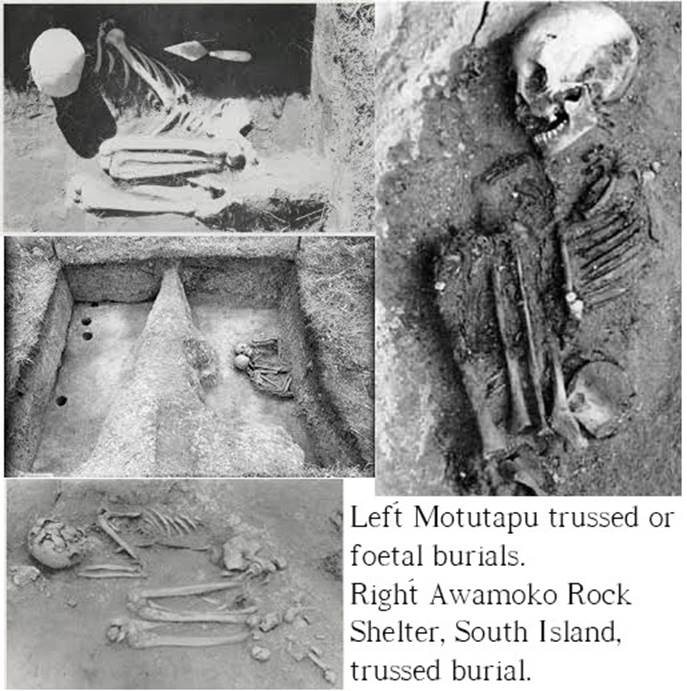
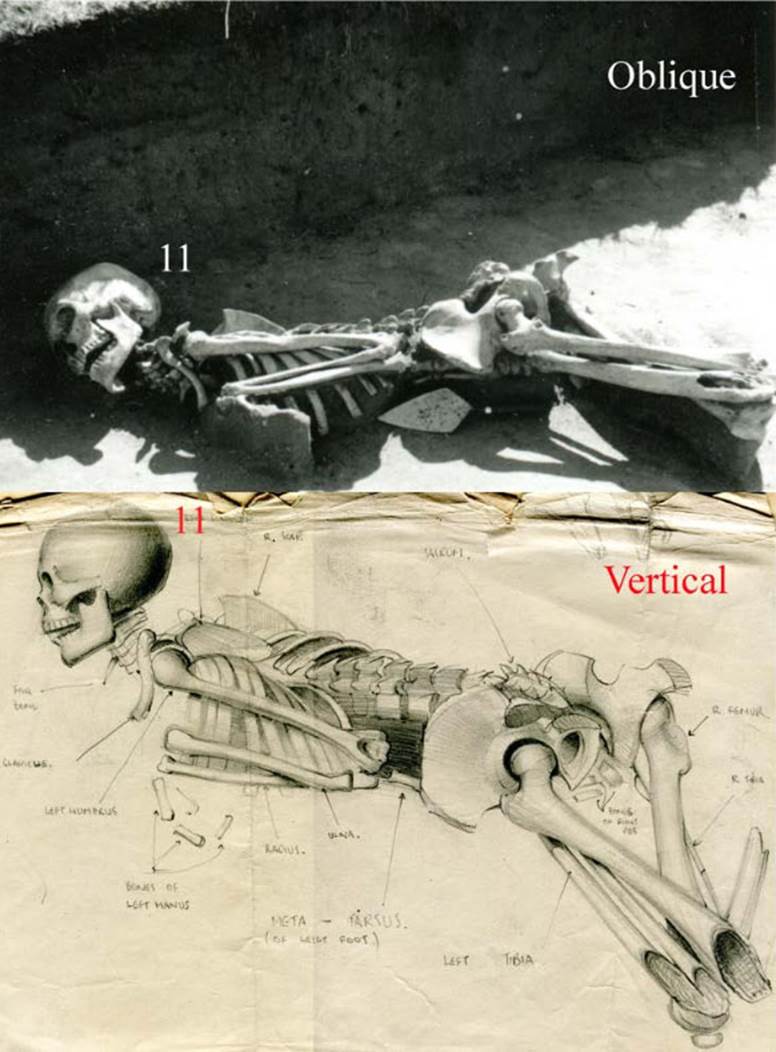
An ancient burial at Opito Bay, Coromandel. Nearby Tahanga Hill was renown for its very hard stone and for the fabrication of very durable adzes. At some of the most ancient archaeological sites in New Zealand adzes from Tahanga Hill have been found, including one in the graves exhumed at Wairau Bar. “One adze found in the 2009 study has been identified by archaeologist Richard Walter as Tahanga basalt from Tahanga Hill near Opito, a well known moahunter area.”
From a carefully placed hubstone atop Tahanga Hill the Winter Solstice sunset is onto the peak of Mount Moehau. There are many fully identified and still-working solar observatories across New Zealand which were set up by the pre-Maori people to get fixes on the Summer & Winter solstice sunrise & sunset events, plus the equinoxes. These many known structures (possibly in their thousands across New Zealand) are never mentioned by our mainstream archaeologists.
The physical anthropology of the Motutapu skeletons (as best as can be seen, for the most-part, in deliberately tiny photos, stingily available for cursory public scrutiny), coupled with the foetal-position or trussed burials of the deceased is indicative of archaic, pre-Maori inhabitants occupying these sites.
But we can list many more comparably, much-settled, terrain-sculptured islands in the Hauraki Gulf such as: Great Barrier, Little Barrier, Mercury, Tiritiri Matangi, Kawau, Waiheke, Browns Island, etc. Further afield one finds significant archaeological sites at Mayor Island, White Island, Matakana Island, Kapiti Island, to name just a few out of many hundreds scattered everywhere else around the coasts of the mainland North & South Islands including the Chatham’s, Stuart Island and even the very cold islands further towards Antarctica.
Added to all of the anciently, much-lived-on islands of Auckland’s Hauraki Gulf are the mammoth excavations that cover the 36+ volcanic cones spread across the city Isthmus.
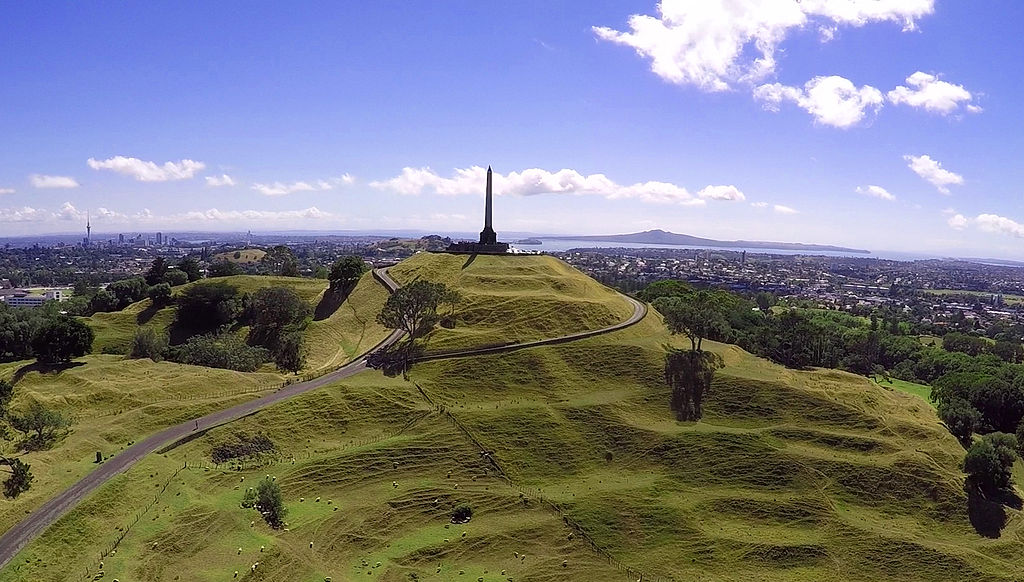
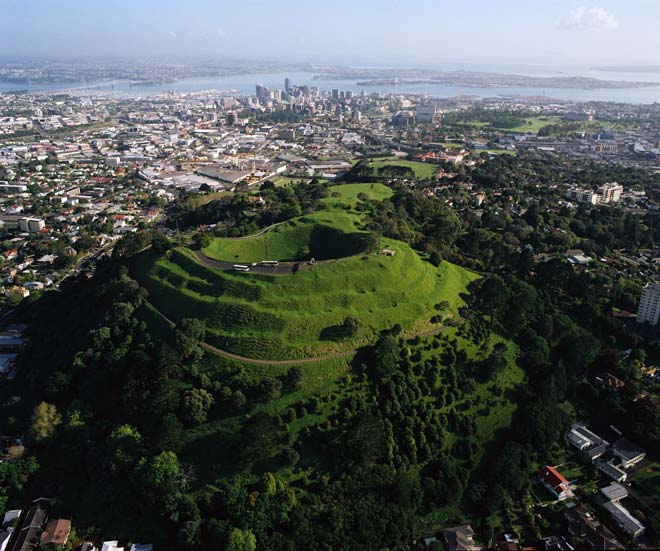

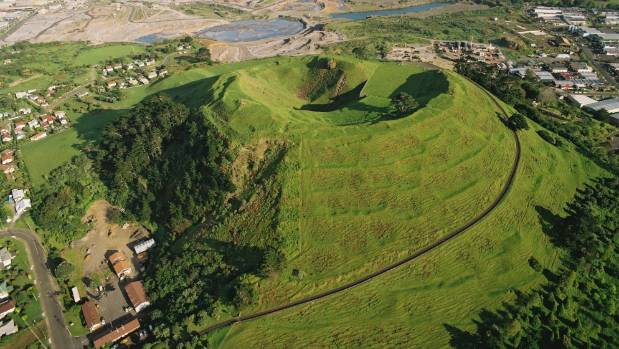
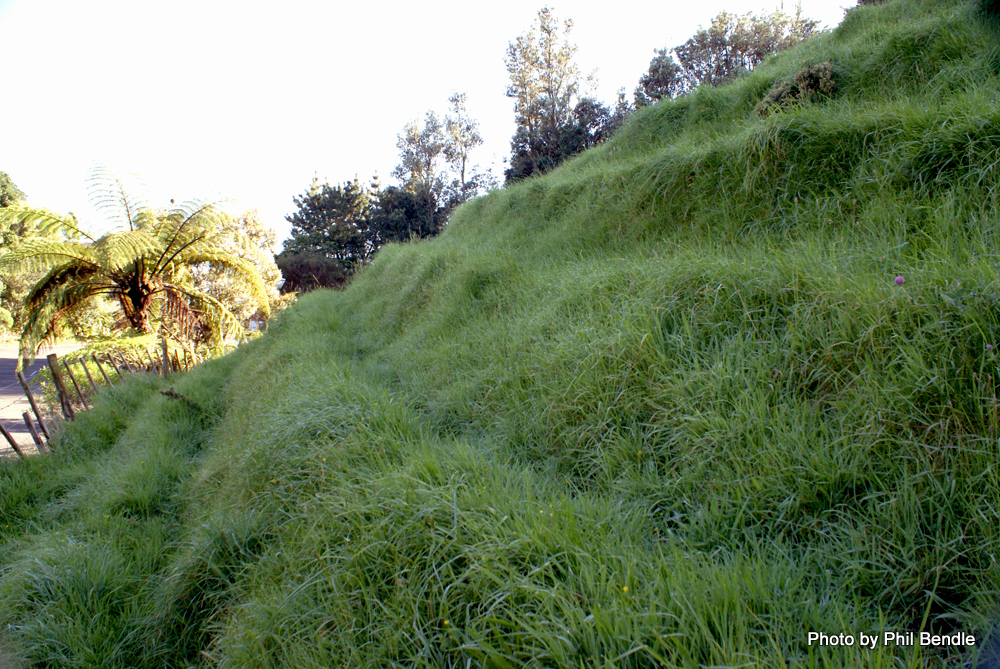
Although our archaeologists state that these are defensive terraces of a PA (fortress), there’s no evidence or logic to suggest any such function. There is no evidence, that I’m aware of, that palisade walls were ever installed on any of these skimpy little terraces and, as far as I know, there are few locations on the laboriously carved Auckland hills where postholes for palisade wooden posts are in evidence.
The massive excavations on the hills afford no discernible defensive capability, although it’s probable that Maori of the 'Musket Wars’ era might have tried to modify small sections or citadels for makeshift defence. One would have to conclude that, around New Zealand, millions of cubic-yards/metres of rock & earth have been moved to form the many sculptured hills everywhere present.
The terraces around the Auckland volcanic cones could never have been a deterrent or obstacle to climbing the hillsides, as one would expect in a defended position designed to ward-off enemies, but would have greatly facilitated scaling up in steps or interlinked paths.
One of the only truly formidable PA in the Auckland region that could be (and was) defended is Pukekiwiriki PA at Red Hill, Papakura. It has sheer, unscalable cliffs on most sides and deep defensive trenches. In the upper half of North Island of New Zealand alone there are 5000 registered PA fortifications, let alone other forms of structures, carved hills, ampitheatres, vast stone wall systems, canals & intensive gardening drain systems, etc. It is impossible that a handful of people arriving in New Zealand around 1300 AD could have built even a small percentage of these massive structures.
Concerning these laboriously carved hills in the Auckland Isthmus we have the commentary of very early colonial observers who were mystified by the sheer magnitude of the excavations:
“There are several very singular hills rising boldly from the surrounding land [Auckland], in shape and form closely resembling the Roman encampments on the Tumuli that abound in many parts of England & having like them three or four distinct fops or ditches encircling them towards the summit - This singular too that these have been formed for defence by the natives - the top of every hill is marked in this way with distinct lines of circumvallation. An antiquary might from this circumstance deduce a connection between the New Zealanders and the ancient Romans!!' (see Felton Mathew's unpublished letters to his wife, Special Collections, Auckland Public Library.
Another early explorer noted:
'Arriving at the foot of the mountain [Mt. Eden] we assayed its ascent in the course of which my friend evinced a deep interest in traces of Maori fortifications of a past age, which were everywhere in evidence, the escarpments, trenches and what had once been covered ways and store pits though fallen in or overgrown, were yet in a wonderful state of recognition.
Several of the stone walls of these fortifications could still be traced with considerable accuracy, although the oldest living Maori could not tell when, or by whom, they were erected.
The Maori race show a wonderful aptitude for field engineering in warfare, and these traces of ancient fortifications, in particular, have often called forth the highest commendation from those most capable of judging such matters.
It must have taken a much larger population than was then to be found to man these fortifications effectively, so extensive were they, the whole mountain appearing to be girt by them, line after line, from bottom to top (see Sketches of Early Colonisation in New Zealand -and its Phases of Contact With the Maori Race, (circa late 1840's), by "Te Manuwiri", pg. 123, Whitcomb & Tombs).
Another publication states:
"Maungawhau, 'the mountain of the whau', a shrub believed to have been growing in the area. The shrub was valued for its cork-like wood, used for floats on fishing nets...Maori legend tells of Maungawhau's [Mt. Eden's] first inhabitants, the Patupaiarehe or Turehu, who were skilled in the arts of fishing, hunting, weaving and warfare. It is said that this nocturnal people were destroyed as they lingered building a bridge after dawn"(see The Changing Face Of Mt. Eden, pg. 8, Mt. Eden Borough Council, 1989).
Note to overseas researchers: There are in excess of 36 large volcanic hills in the Auckland Isthmus that are carved in similar fashion, with much of the terracing through solid lava rock. No-one has yet put forwards a plausible hypothesis as to why Maori would undertake such an exercise. Alternatively, the terraces seem to serve a shadow-play function, like a sun-dial, as the sun rises, sets and moves on its annual journey up and down the horizon.
It's probable that gardeners in the adjacent valley floors looked to the hills for shadow signals with the seasonal rising and setting sun to know when to plant or harvest.
INFIGHTING BETWEEN THE EXPERTS OVER THE KIORE RAT ERA OF INTRODUCTION.

This little rodent (Rattus Exulans or the Pacific Rat) hates water and is a real landlubber. It is agreed that its introduction to New Zealand could only have occurred if it came with humans and this factor has led to major infighting at the academic level.
In The Journal of the Royal Society of New Zealand, Volume 32, Number 3, September 2002, pp. 463-505, is an outstanding article by Dr. Richard Holdaway of Palaecol Research Ltd., and Canterbury University, related to the finding of Rattus Exulan bones under an undisturbed layer of tephra ash from the 186 AD volcanic explosion of Taupo.
The article is titled: Optical dating of quartz sediments and accelerator mass spectrometry 14C dating of bone gelatin and moa eggshell: A comparison of age estimates for non‐archaeological deposits in New Zealand, by Richard N. Holdaway , Richard G. Roberts , Nancy R. Beavan‐Athfield , Jon M. Olley & Trevor H. Worthy, September 2002.
It caused something of a sensation in 2002 when it was released, as it showed positive proof of Rattus Exulans being in residence in New Zealand from before 200 AD and Holdaway was virtually drawn & quartered as a result. His findings flew in the face of and disproved entrenched views about the 1300 AD date for first-humans in New Zealand.
The panic-driven fall-out from Holdaway’s meticulous, scientifically arrived at conclusions, led to the academic community having to reassure the public in 2003 that the 1300 AD date of first occupation was still correct and set in concrete for ‘human impacts’ in the landscape of New Zealand. Hence, The Prehistory Dating Game, by Simon Collins, 24 January, 2003, following so closely on the heels of Holdaway’s findings (September 2002).
A grand meeting of the archaeological-elite was organised at Auckland University and the heretic Holdaway was hauled before the inquisitors who had to decide what damage-control programmes they could implement. In view of the fact that Holdaway’s findings were water-tight, they came to a consensus agreement (majority vote) that, indeed, people had been in New Zealand in 200 AD, but didn’t stay … that was their escape route away from admitting long-term occupation.
However, the more pig-headed advocates of the 1300 AD date were unhappy, but bided their time for a few years before foisting more disinformation upon the otherwise distracted, gullible public. One of their leading-lights, Dr. Janet Wilmshurst, made a grand announcement in June, 2008:
"We are not saying that Maori arrived at any different time than we believed, but we are confirming that Maori were the first people to settle New Zealand. There wasn't this other group that arrived in 200BC.” –Dr Janet Wilmshurst. Christchurch Press, June 4, 08.
Wilmshurst, of Landcare Research, heading an international team, studied rat bones that had been dug up over a four year period and announced that none of them preceded 1280 AD. The follow-on was that Dr David Lowe of Waikato University, earth scientist and senior lecturer, was quoted as stating ‘that the theory of earlier settlement was now quashed…. Flaws in the testing [by Holdaway] may have produced the results.’
In watching the sorry pantomime being played out, a research colleague of mine wrote: ‘Dr Wilmshurst herself jubilantly proclaimed on a TV News item that her results show that the Maoris are indeed the ‘tangata whenua’. Hence, one detects a certain ideological agenda. She was followed by Maori academic and activist Ranginui Walker, stating that ‘the dating disproves the theories on the ‘Moriori’ (an umbrella term sometimes used to denote the pre-Maori people).
Strange that. Professor Ranginui Walker, past Head of Maori Studies at Auckland University, knew Maori were not Indigenous to New Zealand in 1986 when he wrote in the, "1986 New Zealand Year Book" page 18:
“The traditions are quite clear on one point, whenever crew disembarked there were already tangata whenua (prior inhabitants). The canoe ancestors of the 14-century merged with these tangata whenua tribes. From this time on the traditions abound with accounts of tribal wars over land and its resources. Warfare was the means by which tribal boundaries were defined and political relations between tribes established. Out of this period emerged 42 tribal groups whose territories became fixed after the signing of the Treaty of Waitangi and the establishment of Pax Britannica”.
After Dr. Janet Wilmshurst tried to torpedo Dr. Richard Holdaway’s earlier findings by back-stabbing and innuendo that he was somehow mistaken in his earlier results, my research colleague contacted Holdaway to find out how he felt about the Wilmshurst findings. Holdaway replied:
“As usual, Landcare misrepresented my research and results: I have never advocated a 200 BC colonization or even visitation. In fact, I was advocating an AD 1290 settlement before they were. That of course leaves open the question of TRANSIENT visits (think of Lieutenant James Cook). My data indicate some kind of visit by transients about AD 200… during which Pacific rats were introduced. The persistent miscitation of my data and views is rather annoying.
She [Wilmshurst] cannot have been referring to the SAME rat remains (the term “re-dating” is completely misleading because the rat bones are totally consumed in the dating process: dating another rat bone does NOT re-date the first one. That would seem to be common logic…).”
Really, Wilmshurst proved nothing except that the specimens she studied were, deliberately or otherwise, of a more recent date.
Likewise, Holdaway already had his arse-in-a-sling, so to speak, and seemingly dared not to push his luck further in stating that people have inhabited New Zealand for at least 2000-years … If he wants to keep working.
Moreover, Holdaway’s rat specimen was found in the inhospitable, cold, volcanic plateau of the Central North Island. One can legitimately pose the question: If a few rats made it onto land at some coastal location, how long would it take to breed sufficient numbers to force migrations into the centre of the island? How much extra time do we have to add to account for mice making it that far from the coast … 1000-years?
So, there used to be healthy debate about the date of first human contact and settlement of New Zealand, but that has, in recent years, been replaced by a PC approach where dissenters are railed against and subjected to ad hominem attacks if they continue in their heresy and don’t embrace the new light.
As my research colleague eloquently pointed out: ‘The Great Fleet hypothesis stated that Maori found New Zealand in 1350 AD. Dr. Roger Duff put that back to 950 AD on the basis of dating Moa Hunter sites. This was again pushed back to 750 AD by Professor Keith Cumberland in his book, The Moa Hunter, 1965, with the date of 300 AD suggested therein. However he asserted: “Let’s admit it, no one knows when men first reached the islands we call today New Zealand”.
I reiterate, the findings of Russell Price at Poukawa in the 1960s, fully and professionally substantiated by Allan Pullar and Collin Vucetich of the DSIR Soil Bureau, show human habitation dating back to 1350 BC.
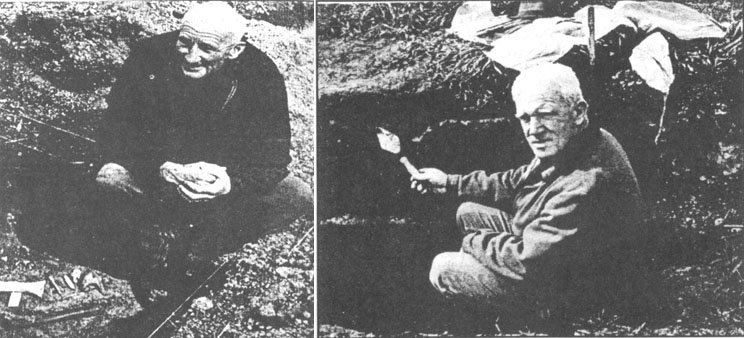
Left: Very careful archaeologist, Russell Price, who did everything by the book and whose research proved ancient human occupation at Poukawa, Hawkes Bay, for an epoch before the Waimihia ash fall of 1350 BC. Right: Pedologist Alan Pullar, an expert on tephra ash band deposits, who fully verified Price's conclusions.
Russell Price's papers are now buried somewhere in the vaults of Te Papa Museum, along with about 22,000 bird bones or other artefacts. Many of these bones were cooked, scraped and marked by human tools or broken open to extract the marrow. This indicated human activity, unless, as Price so eloquently observed, 'ANCIENT MOAS SPENT THEIR TIME BREAKING THEMSELVES UP AND COOKING EACH OTHER'.
WHAT THE MAORI ELDERS AND EARLY COLONIAL RESEARCHERS SAID ABOUT THE PRE-MAORI PEOPLE
In essence, the only way that we can account for the huge works that have been undertaken in pre-colonial New Zealand is to calculate into the equation the fact of long-term, pre-Maori human occupation spanning thousands of years. Maori cultural symbolism and artefacts were derived from the earlier, conquered and annihilated people as the spoils of war. This fact has been alluded to by former researchers.
‘The Maori did not live in this manner in his former home in eastern Polynesia. Did he evolve the pa system after he settled here, or did he borrow it from former inhabitants?’ (see: The Maori As He Was - A Brief Account of Maori Life as it was in Pre-European Days, Chapt. VI, pg. 165).
If the Polynesian Maori brought the artefacts, symbols and motifs here, then why are they not found in their lands of origin? Historian/ anthropologist, Edward Tregear, asked this same question.
Professor Thor Heyerdahl wrote the following on this very subject:
'Irrespective of how and when the Maori began to cover their carvings with spirals, the habit is absent in their Polynesian homeland and may therefore very well be so in their still earlier fatherland further away. There is, indeed, no such curvilinear surface design on the wood carvings of the Society Islands and these include the very tall ancestral posts which were erected in ancient Tahiti' (see American Indians in the Pacific, pg. 116).
And to reiterate the testimony of Hone Mohi Tawhai:
“Well instructed men among the descendants of the Matahourua migration say that when their ancestors arrived in Hokianga they found a people known as "Turehu." Here again we meet with a similar idea to that prevailing among the Aotea people. The Turehu were said to be "He iwi wairua" (a ghostly people). But side by side with this statement we have an admission.
When a child was born among the northern people with reddish hair and a fair skin, it was commonly exclaimed "Ae he Turehu" (yes, this child is a Turehu). The late Hone Mohi Tawhai, who had been carefully instructed by his father, Mohi Tawhai, a renowned priest and warrior of Hokianga, said on one occasion to the writer ; "What do you think will be the destiny of the Maori people?" We replied: "They will be ultimately absorbed in the European people." The reply came: "I think you are right. When the ancestors of the Maori people came to this land they found a people called ‘Turehu' and they fought with them and-intermarried with them, and they were lost in our race.”(See: The Relation of the Aotea Migration to the Question of Previous Inhabitants, by T.O. Hammond).
Shall we just call the learned Maori of old liars? Should we discount as worthless their oral histories and traditions?
My advice to media journalists and sold-out, in-the-pocket archaeologists writing clap-trap history, would be to seek out the old Maori elders and ask them politely to give an account of the pre-Maori Patu-paiarehe and Turehu of their districts.
There’s so much more that could be said about the pre-Maori solar observatories and survey trigs all across New Zealand. Here are a couple of links to that:
http://www.celticnz.co.nz/Split%20Apple%20Rock/WinterSolstice2018.html
http://www.celticnz.co.nz/SolarObservatoriesNZ/SolarObservatoriesPart1.html
Martin Doutré 24/2/19
To be continued, as we haven’t even scratched the surface in trying to explain the many historical, archaeological, anthropological and structural anomalies, etc., for which our mainstream, “so-called experts” can’t provide a rational, believable or acceptable explanation.

